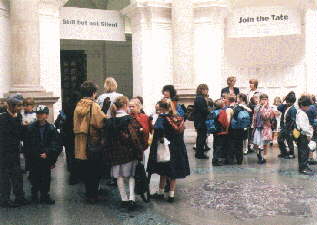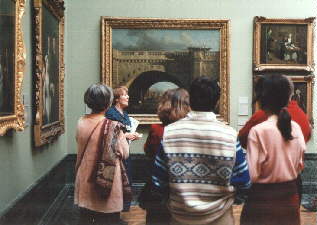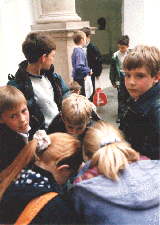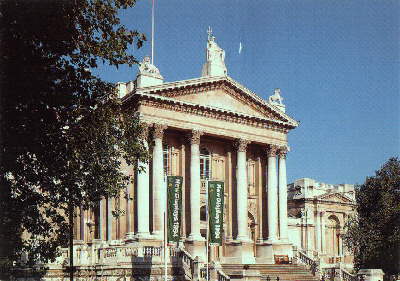
A photo (1 of 2) taken inside the Tate shows young
schoolchildren getting ready for a tour.
Admission to the Tate is free, except for special exhibits, and I can't imagine a trip to England that doesn't include several afternoons in this marvelous art gallery, which first opened in 1897. Not everyone shares my enthusiasm for the Tate, as I was to find out, but on a recent visit to London I managed to sneak off to the Tate on two occasions and enjoyed three docent-led tours: the
The Tate also has a first-class restaurant with a menu that includes everything from bangers and mash ("No filler in the sausage," the waitress assured me) to fresh fish or a hearty roast beef. If you don't want to spend a lot of time or money on a meal, however, there also is a snack bar that offers sandwiches and drinks.

A photo taken inside the Tate shows a docent leading a tour
for a group of adults.
In 1987 the Turner collection was rehoused in the purpose-built Clore Gallery, the most recent addition to the stately Tate.
"He's one of your national treasures," I assured them. "You'll love him."
The girls and I joined the tour and I was glad to see they looked attentive as the guide began telling us about this fascinating man. Turner was born in London, in Covent Garden, where his father was a bartender. He showed talent at an early age and was sent to the Royal Academy of Art school when he was 14. "That's a year younger than you girls are today," I whispered to my charges. If anything, they looked slightly less interested than they had before.
Turner never married but threw himself into his career. He was a prolific, competitive painter all his life who demanded top dollar for his work and could make himself very unpopular with his peers. He became a full member of the Royal Academy at the age of 30.
I noticed one of the girls yawning hugely.
Turner painted historical subjects such as "Snow Storm: Hannibal Crossing the Alps" in which he captured the fury of the squall on land as effectively as he did storms at sea. Light obsessed him and it was only natural for him to go to Venice in the 1830s and paint buildings rising from the mists, clouds and water of this deeply romantic city.
His dramatic canvases featured ships at sea, whaling ships sinking, wooden ships burning, ships trapped by waves - awesome. Too soon the tour was over.
I looked over at the teen-agers. They'd slumped in a corner, comatose, bored out of their minds.
"Would you like to go on another tour, this time on Impressionism and Surrealism?" I asked. "You'll really like it."
"No thanks," they said firmly. "We'll sit outside in the garden and talk. Take your time. We'll wait for you."
They went outside to talk about horses and their upcoming dressage competition and I hurried off to join the next tour, in which we covered "The Three Dancers," a 1925 painting by Pablo Picasso and the 1937 "Metamorphosis of Narcissus" by Salvador Dali.
On my way out of the Tate I saw a large group of young schoolchildren waiting to be shown around the museum.
"Have a great time," I called to them. I only hoped they wouldn't lose interest when they became teenagers.

A photo (2 of 2) taken inside the
Tate shows young schoolchildren
getting ready for a tour.
 The Tate's main entrance is on Millbank, facing the River Thames. It is open Monday through Saturday from 10 a.m. to 5:50 p.m. and Sundays from 2 p.m. to 5:50 p.m. Admission is free. The nearest Underground station in Pimlico. The phone number for information is Tel: 0171-887 8761. The gallery shop is excellent and sells a wide range of books, posters and post cards from the Tate and other collections. There are two restaurants.
The Tate's main entrance is on Millbank, facing the River Thames. It is open Monday through Saturday from 10 a.m. to 5:50 p.m. and Sundays from 2 p.m. to 5:50 p.m. Admission is free. The nearest Underground station in Pimlico. The phone number for information is Tel: 0171-887 8761. The gallery shop is excellent and sells a wide range of books, posters and post cards from the Tate and other collections. There are two restaurants.